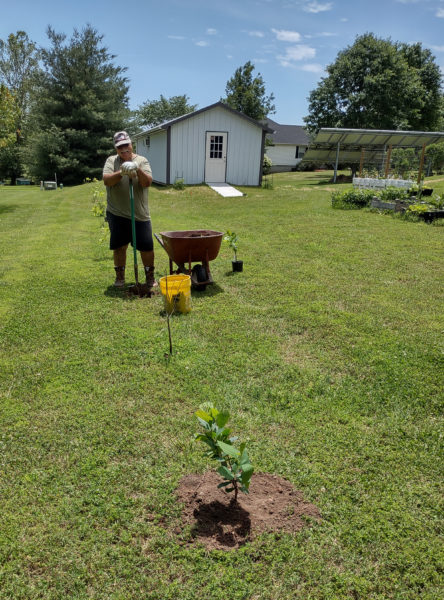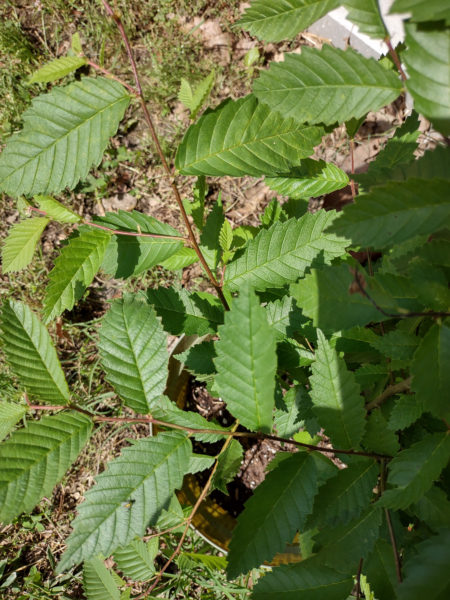Friday afternoon the native plant guy came by and helped us decide on locations for some of the new plants, and came up with ideas for other plants we can use.
There are so many things we can do to help the environment. So, so many of us have fallen into the trap of planting “subdivision” plants. We’ve sprayed weed killer in our yards and in the beds we’re preparing. Native plants are adapted to our region, most have their own defenses for bugs, most can live with the amount of rainfall that’s normal for their regions. I think our landscaping is another example of how we’ve lost our way – no longer growing our own food and trying to kill off every plant that we didn’t plant in our landscaping, even though we have to go to great lengths to keep the non-natives alive because they weren’t necessarily meant to grow in our region.
We’re trying to do better and get rid of the non-natives and go with natives in more of a natural setting. Now that we’ve become more familiar with native plants and how they grow, I love that look so much more than the manicured (not that we have manicured), trimmed shrubs that you see at every house on the street.
The big job for Vince is going to be removing almost all the big shrubs around here. There are four huge Burning Bush plans, a million junipers and about half a million of something else neither of us can remember.

Yesterday Vince spent most of the day planting small trees/shrubs that will hopefully grow up to be big trees/shrubs:
- Service Berry – Fruit can be used in jams, jellies and pies.
- Smooth Sumac – Berries can be used for making a drink similar to lemonade and for a spice.
- Nine Bark – Great for attracting birds and butterflies.
- Witch Hazel – There are all kinds of recipes for skin care products using witch hazel. This is an interesting article about witch hazel. Witch Hazel also protects from erosion on steep slopes so we’re using it around Vince’s shop where lots of dirt had to be brought in for the low side of the foundation. Also, it has a really pretty yellow flower that blooms in the Fall and smells quite nice.
- Chinquapin Oak – I’m so hoping this is an Ozark Chinquapin but I’d bet it’s a Chinquapin Oak. I couldn’t find any mention on the blog where I ordered an Ozark Chinquapin, though I’m always looking for one. Looking at the leaves on what Vince planted yesterday, and comparing the leaves the Chinquapin Oaks we already have planted, I’m hopeful the one he planted is an Ozark Chinquapin.

We’ve joined the Ozark Chinquapin Foundation so hopefully we’ll get some seeds this year.
Here’s a funny article about chinquapin hunting. My uncle had a little chinquapin tree when I was a kid. I don’t know how I kept from dying of a belly ache because I watched that little tree like a hawk and would eat every chinquapin it produced. I don’t know how I even know they were safe to eat or if my parents knew how many of them I was eating.
We’re trying to get rid of a lot of the regular “subdivision” plants and replace them with native shrubs/trees which will attract and be beneficial to bees, butterflies and all kinds of wildlife. Bees, birds and butterflies are what we’re mostly hoping for.
There are probably similar sites for your area but here are sites that have lots of info for MO and some of this might be helpful.

Elle says
Yea you for naturalizing your gardens!!!!! Hard work but oh so fabulous 🙂
Our culture has killed off so much nature with poisons. In 1994 we went 100% organic. I (we) took out the entire backyard grass and started gardening food, annuals and perennials. In 2008 I (we) took out the entire front yard grass. Gardening food, perennials and annuals. We’re on a high mountain desert with a total rainfall of just 13″ annual average. That is very little. We drip irrigate what I plant to be as conservative as we can and we all know nothing consumes more water than grass.
I get a lot of compliments from walkers in the ‘hood. Not once have I been told I should put the grass back 🙂 And it appears I’ve inspired nearby neighbors to take out some grass and grow some food. So awesome to see as their children will know where food comes from!
judy.blog@gmail.com says
Good for you. We all did what was popular and never knew any different. I hope more people will consider doing the same thing.
Nelle Coursey says
A funny thing appeared in my yard this week after all the rains! I have been feeding birds whole peanuts. Well growing up on a peanut farm, I know what the plant looks like! There is one growing under the feeder in the back yard! LOL The birds nor squirrels are eating them, but I guess one fell out and now it is growing into a plant! I will have to put something up to protect it from the man that mows my yard! LOL
So, if you want fresh peanuts in October, plant you some peanuts now and they will be ready in October!
judy.blog@gmail.com says
That’s funny!
Nelle Coursey says
I thought it was funny too! Will let you know if I get any peanuts!!
Sheryl says
..I love reading your posts about going native. We like to think we’re so smart and we don’t know anything compared to these plants who have learned how to thrive in our individual climates.
Rebecca says
Here in southern California, it’s really important to have native plants. The water authorities are campaigning to get people to remove lawns. There may be a place for them, but it’s not here! The San Diego Zoo’s Safari Park has a water-wise garden to take inspiration from. Coming from the Pacific Northwest, though, i yearn for GREEN things. Well, at least where I am, the only gardens in my yard are succulents and ice plant. (Don’t know if ice plant is native, but it sure is plentiful!)
judy.blog@gmail.com says
Just my opinion but I think too many of us never learned the value of native planting and we wanted only what was pretty and what the local nurseries pushed. I find it sad the path we’ve taken that has put us where we are today . . on so many levels. Just following the crowd and never stopping to learn anything different from what we’ve been told.